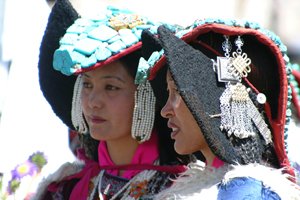
The celebration of blossom flowers called as a flowers festival is held in Nubra valley and road to the Nubra valley is surpassing via Khardung-la pass world highest motorable road 5600mtrs and the mighty Stok Kangri massif of the Zansakr mountain Range and the Indus valley panorama view are seen on the way to K-top and from the K-top you can view the Karakuram range where K2 lie to the extreme north west and see the Saaer-1-2 peak, Rimo and Salto Kangri and the grand canyon valley of Khardong-village, The Shayok and Saichen River confluence in the heart of Nubra valley and enjoy the Bactrian double humped camel riding over the sand dune in the silk route.
Day 1. Leh palace, Red Gonpa and Shanti Stupa.
The legendary Leh-palace was built on the granite hill in 16th century during the reign of Loin king Sengay Namgail. The nine-storeys building which magnificently dominating the view of Leh town is stood out tall despite the central Asian invasion.
Tsemo Gonpa was built on the hill top above the Leh palace in 14th century during the King Tashi Namgail and the chapel represent the reunification of upper and lower Ladakh over central Asian invader and also known as victory peak.
Shanti Stupa was built by Japanese people for peace, harmony and prosperity in the world and it was inaugurated by the His holiness the 14th Dalai Lama in 1985. From the stupa you can catch up the surpassing view Indus valley and the Stok Kangri of Zanskar mountain Range.
Day 2. Shey palace, Thiksay and Hemis monastery.
The old Shey palace of the Ladakh built in 550 years ago by the first king Lhachan Splagyion of Ladakh and the palace has largest golden Buddha statue in Ladakh, the statue worked out of gold and gilded copper sheet was built in 17th century. From the palace you can have a look over the fertile Indus plain and the Indus to Zanskar mountain range.
Thiksay monastery is the oldest monastery of Gelugpa School in Ladakh on the prophesy of great Lama Tsongkhapa the founder of Gylukpa school his disciples great Lama Sharap Zangpo of stod and his nephew Paldan Sharap built the monastery on the bank of Indus river in 14th century and this monastery is as beautiful as comparison to Potala palace and it is known as mini Potala. In 1980 the giant statue of future Buddha was erected and the monastery has largest contingents of monks in Ladakh.
Hemis monastery is located in the hidden mountain of Stok range, Hemis monastery is the school of Drukpa of Tibetan Buddhism was founded by the first reincarnation of Lama Stakstang Raspa from Tibet in 16th century with the support of ladakhi King Sengay Namgail. The festival of this monastery is very popular which held in summer.
Day 3. Leh to Nubra.
Nubra valley it lies situated to the north of Leh and is accessible through the K-top the world highest motorable road 5600 metres.
Samstangling monastery is situated in the village of Sumur it was founded by Lama Tsultim Nima 150 years back. The successive reincarnation of Lama Tsultim Nima and Sars Rinpoche acts as a incumbent of the monastery and Panamic hot spring further 20 km from sumur village.
Sand Dune in the heart of Nubra valley amazing formation of ripples of silver sand dune and enjoy the Bactrian double humped camel riding.
Day 4. Nubra to Leh.
Diskit monastery is one of the beautiful monasteries in Ladakh and it was founded by Lama Sharab Zangpo of Stod in 1420 century and it is the branch of Thiksay monastery. The reincarnation of Skabjay Khanpo Rinpoche acts as incumbent of the monastery and around 100 monks are residing in the monastery.
Day 5. Basgo castle, Likir and Alchi monastery.
In the 10th century when the Yarklung dynasty was founded from Tibet, Bsgos was the western boundary of the kingdom. In 14th century Ladakh dynasty was divided between Basgo and Shey and then in 1470 the king Bhagan from Basgo overcome his cousin in Shey and united the upper and lower Ladakh and moved the capital to leh the Leh palace is living evidience and founded Namail Dynasty.
Likir monastery was built in the 14th century during the reign of fifth king Lachen Gylpo offered land to Lama Duwang chosjay, he was great mediator and in the 15th century Lama Lawng Lodos introduced Yellow order under the head of great Lama Tsongkhapa of Tibet and the abode of the monastery is incarnation of Ngari-Renpochey and the present abode is younger brother of the 14 the Dalai Lama. Monastery is beautifully located in the middle of blue gorge valley of snow cap covered mountain.
Alchi monastery :
The world famous monastery built in the 11th century by the great translator Lama Rinchen Zangpo. Alchi monastery is one of the 108 temples built by Lama Rinchen Zangpo from Guge of western Tibet. The world class Mandala and murals of Alchi different from the rest as it has a fusion of Tibetants and Kashmiri arts.
Day 6.Lamayuru, Rigzong and Phayang monastery.
Visit the 11th century most spectacular picturesque monastery in central Ladakh and is believed to be the oldest and to have been the holy place of the Bon-chos at the advent of Buddhism. The site of lamayuru was lake ages back, when the Arhar Madyantika the disciple of Buddha was travelled to Kashmir and on his way to Ladakh halt for prayer at this place where he tossed grains during his prayer for blessing and he prophesied in future here would arise religious community and later the offered grains in the lake become shape of sawastika and the name of monastery today known as Yungdrung which meant sawastika and also today famously known as a moonland.
Rigzong monastery was founded by Lama Tsultim Nima on returning from Tibet he found a good well here with water and he built monastery there and the abode is reincarnation of Sras Rinpoche and it is isolately located in the middle of Gorge Mountain.
Phayang monastery was founded in 15th century by Chojey Denma Kunga Drakpa from the mount Kailash area in Tibet during the reign of Ladakhi king Tashi Namgail, it is the old monastery as well as the head of Drikung Kargud monastery in Ladakh, its monastery community is headed by His Holiness Drikung Kaybgon Chestang and the practise lineage of Drikung Kargudpa has been unbrokenly transmitted to its Holiness Kapgon Cheytsang and Chungtsnag Rinpoche.


